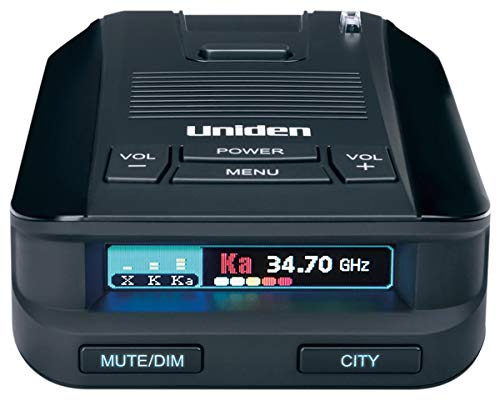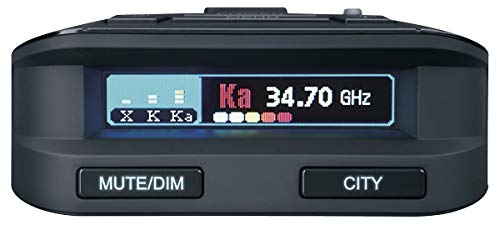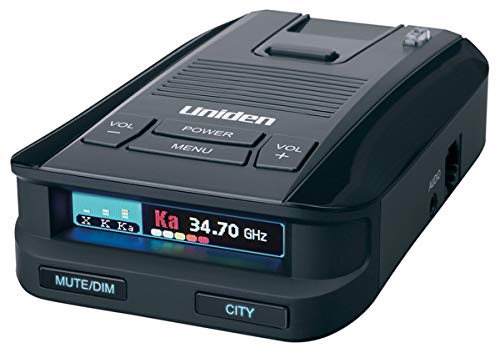The Uniden DFR8 is a solid basic radar detector with good performance, false alert filtering, and features. If you’re just getting started with the DFR8, here’s what all the buttons do and how to program your detector.
Purchase the Uniden DFR8 here.
Note: You can download the Uniden DFR8 owner’s manual. This guide will provide additional information and detail.
DFR8 Top Buttons:
- Power: Turn detector on and off
- Menu: Enter menu, change menu settings
- Long press in menu: Exit menu
- Volume – / +: Adjust volume, previous / next menu option
DFR8 Front Buttons
- Mute / Dim: Mute signals and adjust brightness controls
- Press during an alert: Mute current alert.
- Long press: Change display brightness
- City: Switch between Highway, City, and Advanced sensitivity options
DFR8 Menu Options
Next let’s go over all the settings in the menu options.
Highway / City / Advanced
Adjust the sensitivity of the different radar bands as desired. For maximum performance, run in full sensitivity. To help cut down on false alerts (at the expense of all out range), you can dial back the sensitivity.
Note: Changing these settings do not change anything else or activate any other advanced options besides adjusting the sensitivity of the detector itself.
- Highway: (default) Full sensitivity on all bands.
- City: Reduced sensitivity (about 10% sensitivity) for both X and K band. Ka band remains at 100% sensitivity.
- Advanced: Allows you to individually adjust the sensitivity of X, K, and Ka bands from 40-100% in 20% increments.
Voice
Announces the radar band during an alert. Also announces the menu options as you scroll through.
- On (default): Announce the band and play an alert tone when detecting a signal.
- Off: Play only alert tones when detecting a signal.
Ka Freq Voice
Announces the Ka band frequency when you pick up a Ka band alert. ie. 34.72 GHz.
- On
- Off (default)
X Band
Enable X band if you wish.
X band is mostly phased out across the US and is only in active use in Ohio and southern NJ, as well as in a few rural areas around the country. In most places you can shut it off.
- On
- Off (default)
K Band
Enable detection of K band radar.
K band is actively used by law enforcement across the country. It’s also used by automatic door openers, speed signs, and some blind spot radar.
- On (default)
- Off
Ka Band
Enable detection of Ka band radar.
Ka band is almost always a cop running radar, with very rare exceptions, so you’ll definitely want this on.
- On (default)
- Off
Laser
Enable detection of laser.
Laser jammers are the proper tool to protect you against laser. However, you can enable laser detection in your DFR9 as well if you like.
- On (default)
- Off
Ka POP
Detect 67 ms Ka band POP radar.
POP is a super fast form of radar designed to defeat radar detectors. However, it’s not verified to be actively used anywhere, partly because of the fact that it’s not legal to issue tickets with in the first place. It’s generally recommended to turn off POP detection for better performance and fewer false alerts.
- On
- Off (default)
K Filter
Filter out some false alerts from sources like certain vehicles with radar-based collision avoidance systems. It doesn’t filter out all of them, but it does address many of them. You’ll definitely want this filter on.
- On (default)
- Off
Ka Filter
Filter out false alerts from poorly designed radar detectors nearby that “leak” radar and cause false alerts on your detector.
False Ka alerts are rare so most people turn this off for better performance.
- On
- Off (default)
TSF
Traffic sensor filter. This filters out traffic sensors that line the sides of certain highways. If you get repeated blasts of K band on the highway (not from nearby cars with blind spot monitoring radar), turn this on.
- On
- Off (default)
K Wide / Narrow
Adjust the frequency range that the detector scans for on K band.
- K Wide: (default) (24.050 – 24-250) Scans for the entire range of K band frequencies used by police in the US.
- K Narrow: (24.080 – 24.200) Scans for a reduced range of K band frequencies, narrowing down to the more common frequencies you’ll see while trimming off frequencies that are more likely to be false alerts.
Ka Wide / Narrow
- Ka Wide: (33.4 – 36 GHz) Scans for the entire possible range of Ka frequencies where police are allowed to transmit, including frequencies that are not used by any actual radar guns. However, this will help you catch any out of tune guns.
- Ka Narrow: (default) (33.8 +/- 100 MHz, 34.7 +/- 120 MHz, 35.5 +/- 100 MHz) Scans a narrower range of Ka band frequencies to focus in on the typical range of frequencies that you’ll see police using.
Ka / Signal Priority
When you’re picking up multiple signals, choose which signal is given audible and visual priority.
- Signal Priority: Gives alert priority to the strongest (usually closest) signal.
- Ka Priority: (default) Gives you band priority alerts where if you’re seeing multiple signals, alert priority will be given to Laser, Ka, K, & X in that order.
So for example, if you’re getting a strong K band signal and a weak Ka band signal, Signal Priority will alert you to the K band signal while Ka Priority will focus on the Ka band signal. If you have the all threat display option enabled, the secondary signal will show up on screen next to the primary signal, but the audio will always be focused on the primary signal.
All Threat
When the detector is picking up more than one signal, it can show the band and signal strength of any additional signals (up to 3 more) on the left side of the screen where the voltmeter would normally go. When only one signal is present, that left side of the screen stays as a voltmeter.
- On
- Off (default)
Color
Choose which color display you want. This is helpful if you want the detector to match the colors of your vehicle’s dash lights, for example.
Color options: Red (default), White, Purple, Blue, Amber, Green, Pink, Gray
Scan / Mode Display
Choose what information is displayed on screen when no signal is present.
- Scan: Shows an animated scanning heartbeat display.
- Mode: (default) Displays the current sensitivity mode such as Highway, City, or Advanced.
X / K / Ka Band / Laser Tone
Customize the different alert tones for both radar and laser alerts. There are 12 unique alert tones available.
- X Band: (default = 1)
- K Band: (default = 2)
- Ka Band: (default = 3)
- Laser: (default = 4)
Auto Mute
This will drop the alert volume to a lower level after the detector goes off at full volume initially to get your attention.
- On (default)
- Off
Auto Mute Vol
Choose how quiet the detector gets once it drops down to the auto muted volume level (if enabled.)
Auto Mute Vol: 0 – 5 (default = 2)
Note: If you set this to the same level as the normal alert volume, the detector won’t actually get quieter. Be sure to double-check this setting if that happens.
Dark mode
When the display is set to dark mode (display off when no alert, display turns on when a signal is detected), choose how bright the display turns on to.
- Bright
- Dim
- Dimmer (default)
Auto Dim Setting (only if brightness set to Auto)
The DFR8 has an ambient light sensor to tell the difference between daytime and nighttime. Here you can select the display brightness you want for day vs. night.
- Bright Level: Bright (default), Dim, Dimmer
- Dim Level: Bright, Dim (default), Dimmer
Backlight On/Off
Light up the Mute/Dim and City buttons so you can see them more easily at night.
- On (default)
- Off
BAT Warning
Lets you know if your vehicle’s battery voltage drops below 11v. This can be a helpful reminder if you’re temporarily running your vehicle with the engine off that you’re putting strain on your battery and shouldn’t keep doing that for too long to ensure you can still start your vehicle next time.
- On
- Off (default)
Self Test
The self-test plays the different radar and laser alerts on startup. It doesn’t actually do any testing on startup and is mostly there to verify that the speaker and display are working properly, so I normally just turn this off for a silent startup.
- On (default)
- Off
Factory Reset
Reset your settings back to factory defaults. Press “Menu” to reset your settings. There is no confirmation to reset.
Ver: 1.00 / 1.01
Tells you the firmware version currently loaded onto your detector.
Exit
Exit out of the menu.
Uniden DFR8 Recommended Settings
While there is no one set of settings that is perfect for every person in every area, here are the generally recommended settings that you can start with and customize further as you get more familiar with the detector. These settings basically do things like enable some of the additional filters to help quiet down the detector. If you need to make changes such as enabling X band or TSF, for example, you should definitely make appropriate location-specific adjustments.
Note: I’ve added a (*) at the start of every setting that I’m changing from the default option.
- *Advanced
- X Band: 100%
- *K Band: 80%
- Ka Band: 100%
- Voice: On
- Ka Freq Voice: Off
- X Band: Off
- K Band: On
- Ka Band: On
- Laser: On
- Ka POP: Off
- K Filter: On
- Ka Filter: Off
- TSF: Off
- K Wide
- Ka Narrow
- Ka Priority
- *All Threat: On
- Color: Red
- Mode Display
- Speed Unit: mph
- X Band Tone: 1
- K Band Tone: 2
- Ka Band Tone: 3
- Laser Tone: 4
- Auto Mute: On
- Auto Mute Vol: 2
- Dark mode: Dimmer
- Auto Dim Setting
- Bright Level: Bright
- Dim Setting: Dim
- Backlight: On
- BAT Warning: Off
- *Self Test: Off
Vortex’s DFR8 Settings
These are the settings that I personally run on my DFR8. They may or may not be appropriate for you, of course, but they are what I use. Since I see mostly Ka band here, I run more aggressive filters on K band to help cut down on false alerts on K band.
Note: I’ve added a (*) at the start of every setting that I’m changing from the default option.
- *Advanced
- X Band: 100%
- *K Band: 60%
- Ka Band: 100%
- *Voice: Off
- *Ka Freq Voice: On
- X Band: Off
- K Band: On
- Ka Band: On
- Laser: On
- Ka POP: Off
- K Filter: On
- Ka Filter: Off
- TSF: Off
- *K Narrow
- Ka Narrow
- Ka Priority
- *All Threat: On
- *Color: Blue
- Mode Display
- X Band Tone: 1
- K Band Tone: 2
- Ka Band Tone: 3
- Laser Tone: 4
- Auto Mute: On
- Auto Mute Vol: 2
- Dark mode: Dimmer
- Auto Dim Setting
- Bright Level: Bright
- Dim Setting: Dim
- Backlight: On
- BAT Warning: Off
- *Self Test: Off
Purchase the Uniden DFR8 here.
| This website contains affiliate links and I sometimes make commissions on purchases. All opinions are my own. I don’t do paid or sponsored reviews. Click here to read my affiliate disclosure. |





2 comments
i bought a DFR8 and i finally figured out how to register it on the Uniden website, i have tried for two or three hours to get the updatetool on my windows computer. zip files are giving my a very hard time. i just want to update my firmware on my new DFR8. i can not figure out the website and i am a perfectionist and it is driving me out of my mind trying to get the update! please help, i thought that i was computer literate but i guess i am stupid.
i did plug my detector in and it says connected but that is far as i could get……HELP
Author
If you need tech support, head over to the Uniden section of RDF. https://www.rdforum.org/index.php?forums/169/